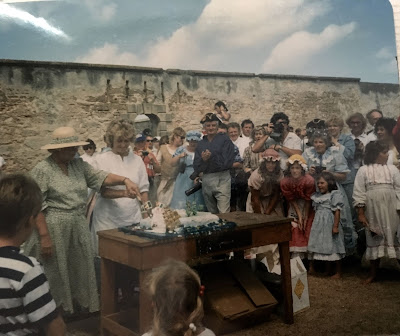A HISTORICAL LOOK AT FOUNDATION DAY
A Foundation Day is generally
understood to mean a day in which people celebrate the settlement of the place
where they live. There was a time when January 26th was known as
Foundation Day because that is when Governor Phillip established the First
Settlement in Sydney Cove. West Australia has celebrated a Foundation Day since
1834 (now known as “West Australia Day”.). It was introduced as a way of
uniting the settlers of the area after it had been created as a colony five
years before.
It is not absolutely certain
when Norfolk Island first celebrated Foundation Day. But we do know from “The
Norfolk Island Gazette” dated 4th March 1938, the people were being
encouraged to organise special celebrations to mark the 150th
anniversary of the founding of the first settlement in March 1788. It would
appear that the day was being promoted from the Administrator’s office, and
special notices were issued by Mr E.Stopp, the Official Secretary. The Gazette
notice reminded the Norfolk people that while they were accustomed to celebrate
June 8th as the beginning of their settlement on Norfolk Island, that
“it is fitting that we should remember the date on which Norfolk Island was
actually occupied as a British Settlement.”
The actual day, March 6. fell
on a Sunday that year. There was a special church service at All Saints’ Church
for all denominations. The offertory from this service was to be directed to a
fund for the building of a new hospital.
Around that time, the Church
of England had just come under the Diocese of Sydney. The Archbishop Dr Moull
arranged for a special commemorative service to be held at St Andrews Church in
Summer Hill in Sydney, and for his sermon to be broadcast on Radio 2CH, and
another special message from the Archbishop to be broadcast on 2BL a little
later in the day. Fancy the Norfolk celebration attracting such widespread
attention.
The Gazette announced that on
Monday 7th, all government offices would be closed, because it would
be a Public Holiday. On the Monday a special Sports Day and Gymkhana was
planned to take place “at the Recreation Reserve” at Kingston. The arrangements
for this were in the hands of Mr H.R. LeClerc.
Events commenced at 1:15p.m.
after a picnic lunch. Various stalls were set up by the different churches and
other community groups. It was also advertised that there would be a Slippery
Dip, a Money Wheel, and a Poultry Wheel. It was announced that there would be
music “with an amplifier.”
The Sports Programme reveals
some fascinating events. It is funny how cars, which had only been on the
island for a few years, had their own events in the Gymkhana! There was a Car
Potato Race and a Car Balloon Race, Ladies Nail Driving, an Old Buffers Race, a
Cross-cut Saw Championship, and a Tug-of-War on horseback. Other events
included a Ladies Sword Race, a Married Ladies Race, Tent Pegging, a Gents
Rescue Race, a Honeymoon Race, and Log Chopping Championships. Chaff was
provided for the horses, and people were asked to keep their dogs at home, or
at least chained to their sulkies. Any entry fee money was to go to the
hospital fund after prizes were distributed.
In the evening, a Ball was
organised by the Ladies’ Hospital Guild. Believe it or not, the Ball did not
commence until 8:45 p.m. Perhaps no one had time to get their chores done and
get into their “gladrags” any earlier!
All Returned Soldiers were requested to wear any medals and decorations.
Once again, the Ball was intended to raise funds for “A Modern Cottage Hospital.”
The Cottage Hospital did not
eventuate and continued in the Bishopscourt premises until the end of the War,
when the new Military Hospital was handed over to the Community. Foundation Day
remained a Public Holiday, but the strength of the celebrations varied. In the
late 70’s, Alice Buffett sought to revive a level of community celebrations on
the 6th March, which was also Alice’s birthday. Alice organised a
number of events for young and old, and many of today’s adults have happy
memories of those activities.
In 1988, the official celebrations
for the BiCentenary were on a large scale. At Kingston Pier, there was a
colourful re-enactment of the landing, followed by a big community picnic.

Everyone attempted to wear period costume. A large number of visitors from First Fleeters groups were there to join in the celebrations. That evening there was a big Ball in Rawson Hall.




Everyone attempted to wear period costume. A large number of visitors from First Fleeters groups were there to join in the celebrations. That evening there was a big Ball in Rawson Hall.



This set the pattern for the
modern day celebrations. The re-enactment now takes place from Emily Bay. The
local people are still conscious of the fact that it is more of a celebration
of British settlement on the island, but is not connected to the Pitcairners’
story. Nevertheless, they are happy to contribute to what has become an
important visitor experience, and to enjoy a “day off’ work while the warm
weather still allows for picnics and swimming.
These pictures show the re-enactment/celebrations in
the 1988 Bicentenary




No comments:
Post a Comment